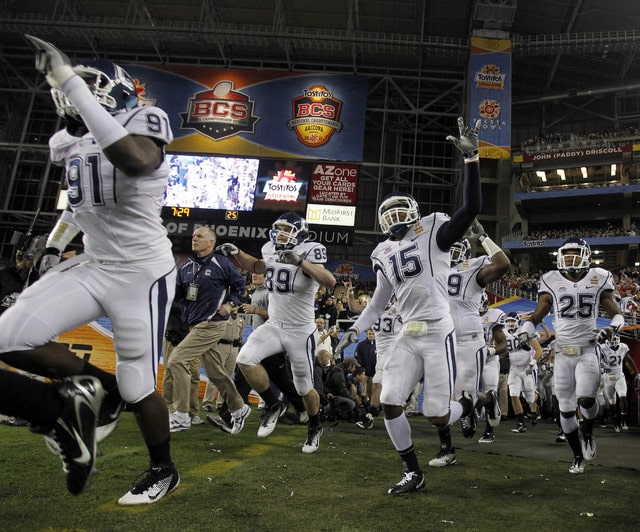

Five years after Connecticut reportedly lost $1.8 million from playing in the Fiesta Bowl, college sports conferences have cut better deals with bowls and put mechanisms in place to protect schools from taking big financial hits from playing in the postseason.
When the record 80 bowl teams are announced Sunday, about 40 percent will be from the so-called Group of Five conferences whose members must be cost conscious to make ends meet. But the days of a bowl team losing money are largely over.
Mid-American Conference Commissioner Jon Steinbrecher, whose league has seven bowl-eligible teams, said he has negotiated contracts with bowl partners the last five years that have allowed him to provide schools an increasing amount of money to cover expenses.
“We didn’t want to see a situation where you have what should be a celebratory thing for the institution,” Steinbrecher said, “and all of a sudden you’re dealing with a multimillion-dollar loss.”
In general, here’s the way bowl finances work: A bowl pays a guarantee amount directly to the conference for each participating team. Guarantees range from several hundred thousand dollars for lower-tier bowls, which draw most of their teams from the Group of Five, to $4.25 million for the Citrus Bowl involving teams from power conferences. The College Football Playoff games and New Year’s Six games are a different beast, paying many millions more to the conferences.
A conference puts the money it collects from bowls into a pool and draws from it to give each participating school a pre-determined amount to cover transportation, lodging, meals and entertainment. Cost overruns are covered by the schools, though conferences sometimes reimburse those that must overspend because of unforeseen circumstances. Any money left over in the pool is distributed to all schools in the league.
Connecticut’s horror story centered on ticket sales, or lack of sales. UConn was allotted 17,500 tickets for the 2011 Fiesta but sold only 2,771, largely because of the distance from the East Coast to Arizona. The Big East Conference, whose last season playing football was 2012, did not have a policy to help schools absorb the cost of unsold tickets. With UConn on the hook for the leftover tickets, its bowl expenses ballooned to $4.3 million, far over its $2.5 million Big East stipend.
The American Athletic Conference, the football spinoff of the old Big East, is on track to have eight bowl teams this year. Spokesman Chuck Dunlap said each of those schools will have a ticket commitment — it varies by game — deducted from its allowance. Every ticket the school sells can go to paying expenses, but unsold tickets aren’t an albatross.
“The setup is designed so that a school would not lose money by playing in a bowl game,” Dunlap said.
Some conferences have negotiated a reduction in the number of tickets its bowl teams are required to sell. This change helps protect schools, and acknowledges that many fans choose to buy less expensive tickets on the secondary market rather than go through the school.
Also, some leagues agree to take the ticket issue out of the schools’ hands altogether and absorb the total cost of those that go unsold. Of course, doing so reduces the bowl revenue distributed to conference members, but it allows individual schools to avoid extreme financial hardship.
The Sun Belt Conference, the weakest of the 10 FBS leagues, three years ago put in place a policy tha0t gives each bowl team $250,000 for expenses in addition to the cost of transportation to and from the bowl site. Teams have no ticket obligation and receive 50 percent of the revenue from tickets they sell. The other half goes to the conference.
“All revenue generated from all bowls will be put toward all bowl expenses,” Sun Belt spokesman John McElwain wrote in an email. “Any ‘out of pocket’ ticket purchase requirement absorbed by the conference is included in the bowl expenses.”
Even without being hamstrung by ticket commitments, schools sometimes do have to tap into their own resources.
The MAC gave Central Michigan a $450,000 allowance for last year’s Popeyes Bahamas Bowl, with $372,000 going for travel. The school reported expenses of $595,000, with meals and lodging for the travel party of 119 causing most of a $145,000 cost overrun the school had to cover.
“You hope to break even or get close to break even,” the MAC’s Steinbrecher said, “but with the exception of a handful of upper-tier bowls, bowls are not money-making operations. You know that going in.”
Central Michigan provided its bowl expense report but did not make athletic administrators available for comment. Steinbrecher said some schools go into bowls planning to spend their own money to enhance the experience for the team and staff or to entertain potential donors.
“What a school may do is build into its budget 50, 100 or 200 thousand dollars (for the bowl), knowing they’re going to get it back through the distribution” that conference schools receive each year,” Steinbrecher said. “It’s all in how you do the accounting.”



